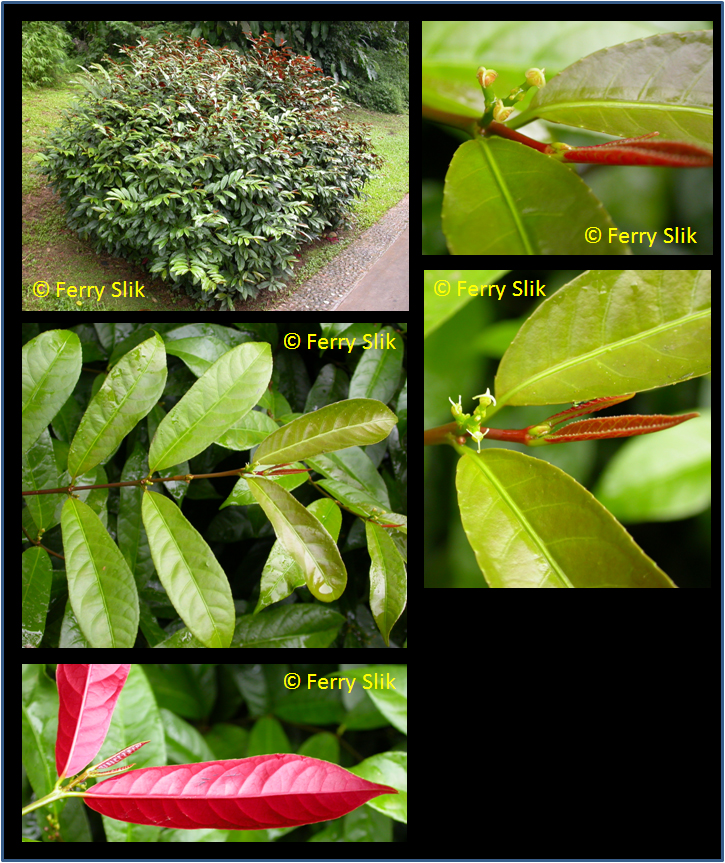Excoecaria cochinchinensis Lour. Fl. Cochinch. 612 (1790)
Name meaning 'from Indochina'.Synonyms
Antidesma bicolor Hassk.
Excoecaria bicolor (Hassk.) Zoll. ex Hassk.
Excoecaria bicolor var. orientalis (Pax & K.Hoffm.) Gagnep.
Excoecaria bicolor var. purpurascens Pax & K.Hoffm.
Excoecaria bicolor var. viridis Pax & K.Hoffm.
Excoecaria cochinchinensis var. viridis (Pax & K.Hoffm.) Merr.
Excoecaria formosana (Hayata) Pax & K. Hoffm.
Excoecaria orientalis Pax & K.Hoffm.
Excoecaria quadrangularis Müll.Arg.
Sapium cochinchinense (Lour.) Kuntze
Description
Evergreen shrubs to 1 m tall; branches glabrous, many lenticellate, often much branched. Leaves opposite, rarely alternate or nearly 3-worled;
stipules ovate, ca. 1 mm; petiole 3-13 mm, eglandular at apex; leaf blade narrowly elliptic or oblong, 6-14 × 2-4 cm, papery, glabrous,
green adaxially, purple or dark red abaxially, or green or greenish abaxially when old, base attenuate, margin serrulate, apex long
acuminate; midvein convex on both surfaces, lateral veins 8-12. Flowers dioecious in axillary or terminal racemes; male inflorescences 1-2 cm,
female ones 3-5-flowered, slightly shorter than male. Male flowers: pedicels ca. 1.5 mm; bracts broadly ovate, ca. 1.7 × 1.7 mm, serrulate
inside base, 2-glandular, each bract 1-flowered; bractlets 2, linear, ca. 1.5 mm, lacerate-serrulate on upper part, 2-glandular at base;
sepals 3, lanceolate, ca. 1.2 mm, serrulate at apex; stamens exserted from calyx; anthers rounded, slightly shorter than filaments.
Female flowers: pedicels strong, 1.5-2 mm, bract and bractlets as in male; sepal 3, slightly connate at base, ovate, ca. 1.8 × 1.2 mm;
ovary globose, glabrous; styles 3, free or ± connate at base, ca. 2.2 mm. Capsules globose, ca. 8 mm in diam., truncate at base, concave
at apex. Seeds nearly globose, ca. 2.5 mm in diam. [from Flora of China]
Ecology
Evergreen or deciduous forests, secondary forests, thickets, also cultivated; below 1500 m.
Distribution
India, Southern China and Taiwan to Vietnam, Thailand, Laos, Burma, Cambodia and Peninsular Malaysia. [Originally from Vietnam?]
Uses
Widely cultivated as an ornamental across the tropics. All parts are used as medicine for measles, parotitis, tonsillitis,
strain of lumbar muscles.
Local names
China: Hong bei gui, Ji wei su.
English: Chinese-Croton, Blindness Tree, Picara.
India: Tsillay cheddie, Tillay Chedday (Tamil).
Indonesia: Ki sambang, Daun remek daging, Sambang daging (Java).
Malaysia: Buta buta, Bebuta, Daun Sambang, Sambang merah, Sambang darah.
Thailand: Ka buea, Kamlang krabue, Lin krabue, Bai thong daeng.
Vietnam: Cay lieodo.
